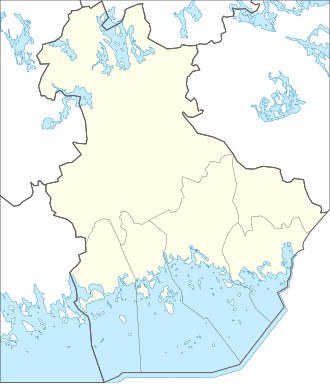This article has multiple issues. Please help improve it or discuss these issues on the talk page. (Learn how and when to remove these messages)
|
| Kymenlaakso Kymmenedalen | |
|---|---|
| Region | |
| Region of Kymenlaakso Kymenlaakson maakunta (Finnish) Landskapet Kymmenedalen (Swedish) | |
 Coat of arms Coat of arms | |
 Kymenlaakso on a map of Finland Kymenlaakso on a map of Finland | |
| Coordinates: 60°30′N 027°00′E / 60.500°N 27.000°E / 60.500; 27.000 | |
| Country | Finland |
| Historical province | Uusimaa, Karelia, Tavastia |
| Former provinces | |
| Capitals | Kotka and Kouvola |
| Other town | Hamina |
| Area | |
| • Total | 5,595.36 km (2,160.38 sq mi) |
| Population | |
| • Total | 174,167 |
| • Density | 31/km (81/sq mi) |
| GDP | |
| • Total | €6.158 billion (2015) |
| • Per capita | €34,350 (2015) |
| Time zone | UTC+2 (EET) |
| • Summer (DST) | UTC+3 (EEST) |
| ISO 3166 code | FI-09 |
| NUTS | 186 |
| Regional animal | Eurasian otter (Lutra lutra) |
| Regional bird | Eurasian bullfinch (Pyrrhula pyrrhula) |
| Regional fish | European sprat (Sprattus sprattus) |
| Regional flower | Yellow Iris (Iris pseudacorus) |
| Regional stone | Rapakivi granite |
| Regional lake | Lake Vuohijärvi |
| Website | www |
Kymenlaakso (Finnish: [ˈkymenˌlɑːkso]; Swedish: Kymmenedalen; lit. "Kymi/Kymmene Valley") is a region in Finland. It borders the regions of Uusimaa, Päijät-Häme, South Savo and South Karelia and Russia (Leningrad Oblast). Its name means literally The Valley of River Kymi. Kymijoki is one of the biggest rivers in Finland with a drainage basin with 11% of the area of Finland. The city of Kotka with 51,000 inhabitants is located at the delta of River Kymi and has the most important import harbour in Finland. Other cities are Kouvola further in the inland which has after a municipal merger 81,000 inhabitants and the old bastion town Hamina.
Kymenlaakso was one of the first industrialized regions of Finland. It became the most important region for paper and pulp industry in Finland. Since the late 1900s many plants have closed, which has caused some deindustrialization, unemployment and population decline in Kymenlaakso, especially in those communities that were built around plants in Kouvola.
Historical provinces
For history, geography and culture see: Uusimaa, Karelia and Tavastia
History

Kymenlaakso, cradled by the winding Kymi River, boasts a history as dynamic as its waterways. Unlike Finland's traditional provinces, Kymenlaakso emerged as a distinct region much later, a testament to its ever-evolving character. The earliest whispers of human presence in Kymenlaakso echo back to the Stone Age. These settlements laid the foundation for later inhabitants like the Tavastians and Karelians, who etched their own stories onto the land.
For centuries, Kymenlaakso found itself under Swedish rule. Its strategic location transformed it into a vital trade corridor between Sweden and Russia. This era also witnessed the birth of its industrial prowess, with the 18th century ushering in an iron and steel boom. Sawmills and paper mills sprouted like mushrooms along the riverbanks, laying the groundwork for Kymenlaakso's future industrial dominance.
The 19th century brought a shift in political winds as Kymenlaakso became part of the Grand Duchy of Finland in personal union with the Russian Empire. However, the region's industrial spirit remained unfazed. In fact, this period saw further consolidation of its industrial base. The early 20th century witnessed another significant development – the rise of a powerful labor movement, a reflection of the growing importance of the working class in Kymenlaakso's industrial landscape.
Following World War II, Kymenlaakso embraced its place in independent Finland. While industry remained the cornerstone of its economy, forestry and tourism began carving out niches for themselves. However, recent years haven't been without challenges. The decline of the forest industry has cast a shadow over the region. Undeterred, Kymenlaakso is actively pursuing economic diversification, attracting new businesses and exploring new avenues for growth.
Municipalities
Main article: Municipalities of KymenlaaksoThe region of Kymenlaakso consists of six municipalities, three of which have city status (marked in bold).
Municipalities on the map

Savo
Karelia
Leningrad
Oblast
Häme
Sub-regions
 Kotka
Kotka Hamina (Fredrikshamn)
Hamina (Fredrikshamn) Pyhtää (Pyttis)
Pyhtää (Pyttis) Virolahti (Vederlax)
Virolahti (Vederlax) Miehikkälä
Miehikkälä
Municipalities listed

| Coat of arms |
Municipality | Population | Land area (km) |
Density (/km) |
Finnish speakers |
Swedish speakers |
Other speakers |
|---|---|---|---|---|---|---|---|
 |
Hamina | 19,375 | 610 | 32 | 92 % | 0.3 % | 8 % |
 |
Kotka | 50,336 | 272 | 185 | 89 % | 1 % | 11 % |
 |
Kouvola | 78,514 | 2,558 | 31 | 95 % | 0.4 % | 5 % |
 |
Miehikkälä | 1,723 | 423 | 4 | 95 % | 0.3 % | 7 % |
 |
Pyhtää | 5,027 | 325 | 15 | 89 % | 6.8 % | 5 % |
 |
Virolahti | 2,860 | 372 | 8 | 95 % | 0.4 % | 7 % |
| Total | 157,835 | 4,559 | 34.6 | 92.4 % | 0.7 % | 7 % |
Former municipalities
Politics
Results of the 2019 Finnish parliamentary election in Kymenlaakso:
- Social Democratic Party 24.73%
- Finns Party 20.93%
- National Coalition Party 18.21%
- Centre Party 11.64%
- Green League 8.64%
- Left Alliance 6.34%
- Christian Democrats 4.85%
- Movement Now 1.83%
- Blue Reform 1.68%
- Seven Star Movement 0.33%
- Other parties 0.82%
References
- Regions and Cities > Regional Statistics > Regional Economy > Regional GDP per Capita, OECD.Stats. Accessed on 16 November 2018.
External links
| Regions of Finland | ||
|---|---|---|
| Regions | ||
| Former regions | ||
